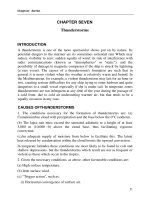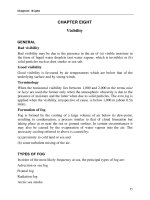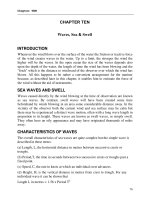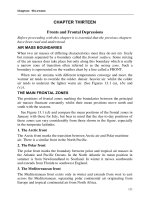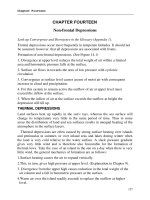BÀI GIẢNG KHÍ TƯỢNG LÝ THUYẾT CHƯƠNG 17
Bạn đang xem bản rút gọn của tài liệu. Xem và tải ngay bản đầy đủ của tài liệu tại đây (102.84 KB, 10 trang )
Chapter Seventeen
CHAPTER SEVENTEEN
Avoidance of the worst effects of a Tropical
Revolving Storm
PART 1- INTRODUCTION
In any locality during the tropical revolving storm (TRS) season the navigator must
exercise constant vigilance to ensure that he is not caught unawares in the path of a
storm. Fortunately nature provides warning signs to the alert; also the
meteorological services ashore broadcast very valuable warnings by radio*
whenever it is available from ship and/or other sources.
*See Admiralty List of Radio Signals Vol. III
The mariner's aim must be to avoid getting near the centre of the storm; here
again nature provides these storms with certain common features which has
enabled the evolvement of guidance "rules" to help in keeping the ship out of
serious trouble.
Except for the behaviour of the barometer, anyone of the following warning
signs, if taken alone, is only an uncertain indication of the approach of a TRS.
Barometer, swell, sky, etc, must be considered together.
NATURAL WARNINGS
(A) THE BAROMETER. In temperate latitudes atmospheric pressure is subject
to large, rapid and very irregular daily changes caused by the development and
movement of travelling weather systems. In the tropics however, in normal
weather. the day to day changes in the readings of the barometer are very small and
follow a very regular pattern of diurnal variation: consequently the barometer
needs to be corrected for its diurnal variation.
Figure 17.1 shows a typical curve of pressure changes for a day in the tropics.
The maxima occur at 1,000 and 2200 hours, local time, and the minima at 0400
and 1600 hours. The range of daily change averages 3 hPa (about 0.1 in) at the
equator, decreasing with latitude (N and S) to 2.5 hPa at latitude 30° and 1.7 hPa at
35°.
Whenever in any region and season when tropical cyclones are likely to
occur, no matter how fine and settled the weather may appear. the barometer
should be read and recorded every hour. The reading, after having being
reduced to sea level, should then be corrected for diurnal variation. *Each
147
Chapter Seventeen
reading thus corrected should be compared with the mean pressure for the
locality and season (as shown in the Admiralty Pilot or Meteorological
Climatological Atlas) and, if it is 3 hPa or more below the mean pressure, or if
there is a marked departure from the diurnal variation, there is a risk of a TRS
forming or developing and a warning signal should immediately be sent by
radio to the nearest coast radio station and repeated to all ships.
If a corrected reading is as low as 5 hPa below normal it should be taken to
mean that a TRS is almost certainly somewhere in the area and probably within
200 miles of the observer.
When the storm is 500 to 1,000 miles away the barometer usually becomes
unsteady and often rises a little above the normal This is followed by a definite
slow fall, usually over a distance of 500 to 120 miles from the storm centre,
thereafter the rate of fall increases becoming rapid on the near approach of the
centre.
(B) APPEARANCE OF SKY. Vivid colouring at sunrise and sunset are
often a warning feature, accompanied or followed by cirrus cloud, not
infrequently in V-shaped formation pointing towards the centre. Cirrus may
first appear when the storm is from 300 to 600 miles away and is often the first
warning of a TRS, even in the early stages of development. Later there will be
altostratus and eventually cumulus fractus and scud.
*Caution: When entering a barometric pressure in the log book, or when
including it in a radio weather report, the correction for diurnal variation should
NOT be applied. This correction is only for the "}faster's operational use during
the tropical cyclone season in the area.
148
Chapter Seventeen
(C) SWELL. There will be a long swell coming from the direction of the
storm centre provided there is no land intervening between the storm and the
ship. The swell travels faster than the storm and usually extends more than 400
miles al1d sometimes 1.000 miles from the centre. Thus it may well be the first
warning sign.
(D) VISIBILITY. Exceptionally good visibility frequently precedes a
tropical revolving storm.
(E) W1ND. During the storm season an appreciable increase in wind force
and/or direction should also be regarded as a possible indication of the
approach of a TRS .
WARNING BY RADAR
The average merchant ship's 3 cm radar can, in normal propagation conditions,
display rain at a maximum range of about 30 miles, so its value in warning of a
tropical storm is very limited. Nevertheless, within that range very clear radar
screen pictures of the rain belt surrounding the "eye" (vortex) have been seen,
the eye itself showing as a dark circular area in the centre. But by this time the
ship will have already become heavily involved in the storm. A greater range
of detection can be expected with 10 cm radar.
RADIO WARNINGS FROM A METEOROLOGICAL SERVICE
All ocean areas which are visited by tropical storms are now covered by radio
weather bulletins and storm warnings issued by one or more local
meteorological services.
Images from meteorological satellites· provide valuable information about
existing storms and their development, and in some areas reconnaissance
aircraft keep in contact with each storm.
Provided that the extent, wind force, existing track and speed of movement
of a storm are known, detailed warnings can be broadcast to shipping at
suitable intervals including forecasts of the storm's probable behaviour. But
these storms are born in mid-ocean and, in the absence of ship reports
(supplemented by aircraft reports and/or satellite pictures) the meteorologists
cannot know of a storm's existence. This is recognised by the International
Convention for Safety of Life at Sea which requires the master of any ship who
suspects the existence of a tropical storm to report it.
With the advent of the Global Maritime Distress and Safety Systems
(GMDSS) a large proportion of ships no longer carry qualified radio officers.
Information concerning meteorological warnings, including that relating to
TRS is principally conveyed now by Telex or Navtex.
*See Appendix 1.
149
Chapter Seventeen
MASTER'S ACTION WHEN STORM SUSPECTED OR KNOWN
TO EXIST
Article 35 of the International Convention for Safety of Life at Sea calls for a
safety message to be sent as soon as possible to the nearest authority ashore and
broadcast to shipping in the vicinity. Such a message might read: Storm
Warning.
Typhoon seems to be developing. 0840 GMT. August 15. 0635N, 133°20'E.
Barometer corrected 1,000 hectopascals, tendency down 3 hectopascals. Wind
NW Force 4. Moderate westerly swell. Cirrus clouds. Course 345. 15 knots.
Similar reports should be sent at intervals of not more than 3 hours until the
ship is clear of the storm .
It is in the interest of the reporting ship and all other ships that coded weather
reports be sent also to meteorological authorities at frequent intervals. Normal
seamanlike precautions should be taken on board for exceptionally rough
weather.
PART II- PRACTICAL RULES FORA VOIDING THE WORST OF A
TROPICAL STORM
As the isobars in a tropical revolving storm are always circular in shape the
storm field has two semicircles which, for safety purposes, are classified as
“dangerous" and "navigable" (see Figure 1-2).
The dangerous semicircle is the right-hand one in the northern hemisphere
and the left-hand one in the southern latitudes. It is termed dangerous because
the winds therein tend to blow a ship into the path of the advancing storm's
centre, or the storm might recurve and the centre pass over the ship. The
advance quadrant of this semicircle is particularly dangerous.
In the navigable semicircle the winds tend to blow the ship towards the rear
of the path, and it lies on that side of the path which is away from the direction
in which a storm usually recurves.
Before deciding on evasive action the master needs to know:
(a)The bearing (and if possible the distance) of the storm's centre.
(b) The semicircle in which the ship is located.
(c) The likely path of the storm.
1. FIND THE BEARING OFTHE CENTRE
Use Buys Ballot's Law (see Appendix 1). Remember the wind crosses the
isobars at an angle of about 45° at the edge of the storm field. decreasing until
150
Chapter Seventeen
nearly parallel with the isobars near the centre. Face the wind and the centre
is on your right in the northern hemisphere and on your left in the southern
hemisphere. Allow about 12 compass points when the corrected barometer
reading starts to tall, then 10 points when it has fallen 10 hPa (0.3 in) and 8
points if it falls 20 hPa (0.6 in) or more. The wind direction tends to be erratic
during squalls. The best time for observing is when the wind steadies just
after a squall.
2. TRYTO ESTIMATE DISTANCE FROM CENTRE
As a very rough guide, in the absence of detailed meteorological data, the
centre would probably be about 200 miles away if the corrected barometer
reading is 5 hPa (0.15 in) below the local normal and the wind Force is about
6. If the wind force is 8 the centre is probably within 100 miles.
3. FIND OUT IN WHICH SEMICIRCLE THE SHIP IS LOCATED
To a stationary observer in either hemisphere, the wind shifts to the right in
the right-hand semicircle and to the left in the left-hand semicircle. Therefore
to eliminate the relative motion problem between ship and storm. the master
should heave-to or stop the ship to find out the true windshift and thus
determine the semicircle.
If the wind veers the ship is in the right-hand semicircle: if it backs she is
in the lefthand semicircle: if it is steady in direction she is in the direct path
of the storm.
The barometer falls ahead of the trough and rises in the rear, thus the
quadrant can also be determined.
4. TRY TO FINDTHE LIKELY PATH OFTHE STORM
Provided the ship is either stopped or hove-to, a very rough estimate of the
storm's probable path can be made by working out two bearings of the centre
(as described earlier) with an interval of about 3 hours between them. The
storm is unlikely to be decreasing its latitude and, if the latitude is less than
20° it is unlikely to be making any movement towards the east.
A diagram similar to Figure 17.2 (but omitting the ship) on a piece of tracing
paper will be found useful here in deciding what action to take.
The answers to all the above questions will be very greatly facilitated if
official information about the storm's behaviour has been received by radio
from a meteorological service.
151
Chapter Seventeen
ACTION TO AVOID THE WORST OF THE STORM: NORTHERN
HEMISPHERE
RIGHT-HAND OR "DANGEROUS" SEMICIRCLE (Figure 17.2. Ship A). If
under power proceed with maximum practical speed with wind ahead or on
starboard bow, hauling round to starboard as the wind veers. If sea room is
inadequate to make headway, or if the ship is under sail only, then heave-to on
starboard tack.
LEFf-HAND OR "NAVIGABLE" SEMICIRCLE (Figure 17.2. Ship B). Run
with the wind well on the starboard quarter (whether under power or sail)
making all possible speed and haul round to port as the wind backs. If searoom
is insufficient to make headway, heave-to on whichever tack is considered to
be the safest under existing circumstances and conditions.
IN DIRECT PATH AND AHEAD OF STORM (Figure 17.2. Ship C). With
the wind on the starboard quarter make all possible speed into the navigable
semicircle. If inadequate sea room to do this, it may be preferable to proceed
into the dangerous semicircle rather than stay in the direct path, but be on the
alert for possible recurvature .
VESSEL OVERTAKING THE STORM (Figure 17.2. Ship D). This may not
be unusual in the fast ships of today. HEAVE-TO; the wind will then shift to
the right and the barometer will rise showing that ship D is in the rear quadrant
of the dangerous semicircle. She should then get the wind on the starboard bow
(Ship E) and allow the storm to get clear.
If ship D does not heave-to when the storm is first suspected and continues
on course. the barometer will fall and the wind will shift to the left. This can
lead to an erroneous assumption that she is in the left-hand semicircle ahead of
the trough; if she then proceeds (obeying the rules) with the wind on the
starboard quarter she may run into the dangerous quadrant, especially if her
original course was converging with the path.
SOUTHERN HEMISPHERE-ACTION
Exactly the same principles apply as in the northern hemisphere, but because
the wind circulates clockwise the left-hand semicircle is the "dangerous" one
and the right-hand one is "navigable". Thus the action to be taken to keep the
ship clear of the worst of the storm is different, as summarised below.
LEFT-HAl'ID OR "DANGEROUS" SEMICIRCLE. (Figure 17.3. Ship F). If
under power proceed at ma...'illnum practicable speed with the wind ahead or on
port bow hauling round as the wind backs. If impracticable to make headway,
heave-to on the port tack.
152
Chapter Seventeen
RIGHT-HAND "NAVIGABLE" SEMICIRCLE. (Figure 17.3. Ship G). Run
with the wind on the port quarter making all possible speed and hauling round to
starboard as the wind veers. If impracticable to make headway, heave-to in the
most comfortable position.
ON THE STORM PATH AHEAD OF THE CENTRE. (Figure 17.3. Ship H).
With the wind on the port quarter make all possible speed into the navigable
semicircle. If there is insufficient sea room for this, act as described for northern
hemisphere.
VESSEL OVERTAKING TIIE STORM. (Figure 17.3. Ship J). Heave-to;
the windshift to the left and rising barometer will show ship J to be in the rear
quadrant of the dangerous semicircle. Get the wind on the port bow (Ship K).
USE OF SAFETY SECTORS-ADDITIONAL PRECAUTION
The following procedure is only possible when accurate, regular radio reports
of the storm's progress are available. (refer to Figure 17.4.)
1.On the chart, plot the reported position of the storm's centre (A).
2. From A layoff the track and distance the centre is expected to make during
153
Chapter Seventeen
the next 24 hours (AB).
3. With A (the "eye") as centre and radius AB construct an 80° sector (with 40°
on each side of the track).
4. Endeavour to keep the ship outside this sector which is a "dangerous area".
5. Each time the storm alters its direction of movement, layoff a new sector.
The normal " rules" for avoiding the worst of a TRS must still be adhered to in
principle.
SHIP IN HARBOUR.
When in harbour. whether lying alongside or at anchor. during a tropical storm
season or period, vigilance must be maintained as at sea. Barometer, wind and
sky need watching carefully and it is desirable, if practical, to set a modified
radio listening watch for weather bulletins.
If a storm is threatened, early seamanlike precautions must be taken. If it seems
likely that the storm centre will pass near by it may be best to proceed to sea,
provided there is plenty of sea room available. If remaining in harbour and at
anchor there is the likelihood of having to use main engines and/or to let go a
second anchor. Buoying the anchors with brightly painted buoys might well
facilitate their successful use for this purpose.
A small ship at sea within access of a suitable harbour may benefit by seeking
shelter rather than remaining at sea.
154
Chapter Seventeen
LOCAL PECULIARITIES OF TROPICAL STORMS
CHINA SEA AND WESTERN NORTH PACIFIC. If there is a fairly steady SW
or NW wind in June to September in the northern part of the China Sea, a typhoon
to the northward is probable, the reason being that there is no season when these
winds are normally common; even the SW monsoon is usually from the S or SE.
SOUTH INDIAN OCEAN. An approaching cyclone may be masked by the SE
trade wind; should the trade wind approach gale force the ship should be hove-to
so as to observe the wind-shift.
In all tropical revolving storm areas the behaviour of a storm may be very
erratic.
QUESTIONS
1. a) Explain why the "dangerous" and "navigable" semicircles of a T.R.S are so
named.
b) Which is the "dangerous" semicircle in a T.R.S of the southern hemisphere?
2 Explain why, when you find yourself in the vicinity of a tropical cyclone, you
should stop your ship or heave to before deciding what action you should take to
avoid the storm.
3. a) On a voyage from Sydney, Australia, to Fiji, you observe the warning signs of
the approach of a hurricane. Describe how you would estimate the bearing of the
storm's centre, the quadrant in which your ship is located, the probable path of
the storm and your distance from the vortex.
b) What action should be taken if found to be (i) in the dangerous quadrant or (ii)
in the direct path of the storm?
4. List the signs which would indicate the probable approach of a T.R.S.
5. Tropical cyclone form mostly on the western side of the oceans. Why is this so?
6. What action must a ship's master take in accordance with Article 35 of the
international Convention of Safety of Life at Sea, when the presence of a T.R.S.
is suspected or known to exist?
7. a) What is the average diurnal range of atmospheric pressure within the tropics?
b) State the local times at which the maximum and minimum pressures occur.
c) When engaged in a voyage where tropical cyclones may be encountered,
corrected barometric readings must be further adjusted for local diurnal
variation. State where the normal barometric pressure and the diurnal range
for any particular locality and month can be found.
155
Chapter Seventeen
8. You are in Port Suva, Fiji. A hurricane is approaching from the north.
Describe the sequence of wind and weather you would probably experience
if the storm subsequently passes a) to the eastwards of your position and b)
to the westwards.
9. You are in the direct path of a typhoon which is travelling north. There is
insufficient sea room for you to run and there is no available shelter. What
action would you take? Explain why.
10. A ship's position is in latitude 300N, longitude 70oW, bound from Bermuda
to the Bahamas on a course of 240o. Warning is received of a hurricane
centred over the Florida Straight and which is moving N.E. State what
action should be taken and give reasons for your answer.
11. Describe with the aid of a diagram how safety factors should be used to
avoid the worst effects of a T.R.S. Assume that regular radio reports about
the storm's progress are being received.
156


